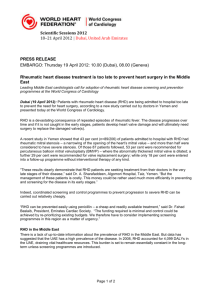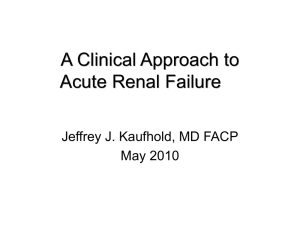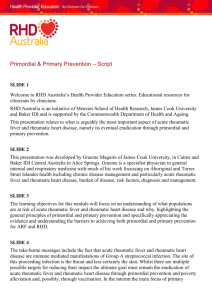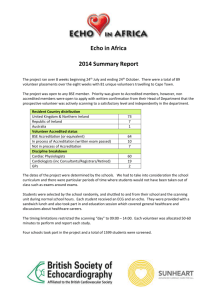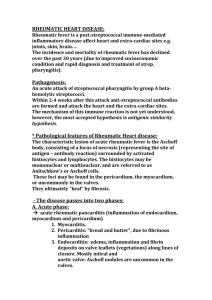Script (DOC) - RHD Australia
advertisement
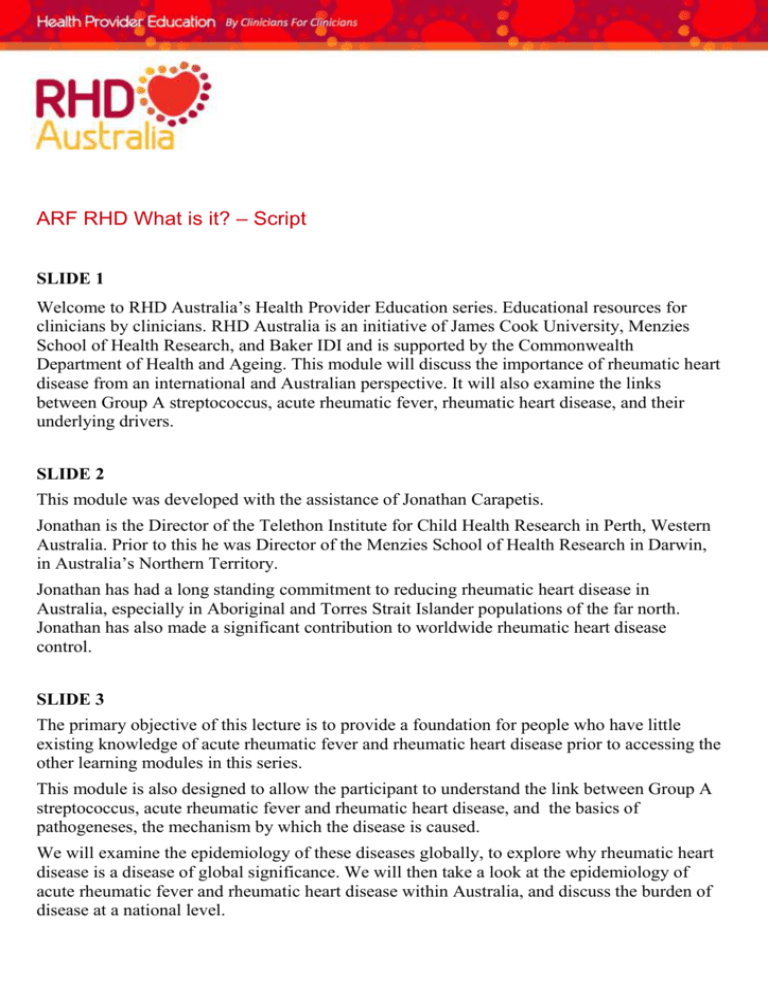
ARF RHD What is it? – Script SLIDE 1 Welcome to RHD Australia’s Health Provider Education series. Educational resources for clinicians by clinicians. RHD Australia is an initiative of James Cook University, Menzies School of Health Research, and Baker IDI and is supported by the Commonwealth Department of Health and Ageing. This module will discuss the importance of rheumatic heart disease from an international and Australian perspective. It will also examine the links between Group A streptococcus, acute rheumatic fever, rheumatic heart disease, and their underlying drivers. SLIDE 2 This module was developed with the assistance of Jonathan Carapetis. Jonathan is the Director of the Telethon Institute for Child Health Research in Perth, Western Australia. Prior to this he was Director of the Menzies School of Health Research in Darwin, in Australia’s Northern Territory. Jonathan has had a long standing commitment to reducing rheumatic heart disease in Australia, especially in Aboriginal and Torres Strait Islander populations of the far north. Jonathan has also made a significant contribution to worldwide rheumatic heart disease control. SLIDE 3 The primary objective of this lecture is to provide a foundation for people who have little existing knowledge of acute rheumatic fever and rheumatic heart disease prior to accessing the other learning modules in this series. This module is also designed to allow the participant to understand the link between Group A streptococcus, acute rheumatic fever and rheumatic heart disease, and the basics of pathogeneses, the mechanism by which the disease is caused. We will examine the epidemiology of these diseases globally, to explore why rheumatic heart disease is a disease of global significance. We will then take a look at the epidemiology of acute rheumatic fever and rheumatic heart disease within Australia, and discuss the burden of disease at a national level. We will move on to investigate how it is managed and controlled with an overview of the Australian acute rheumatic fever and rheumatic heart disease control programmes. Finally we will conclude by highlighting the underlying health determinants of these conditions. SLIDE 4 The most important take home messages from this presentation are: 1. That acute rheumatic fever and rheumatic heart disease are diseases of poverty and indeed of social injustice; 2. That there are environmental as well as genetic causes; 3. That we have many proven effective control and management strategies that can be used right now, which leads us to the final point 4. To be successful, these programs need adequate long term funding and demonstrated political will 5. In the end, it is sustainable political and economic commitment that is essential in the control of these diseases. SLIDE 5 Before proceeding further, it is worthwhile defining the terms and abbreviations that will used. APSGN refers to acute post streptococcal glomerulonephritis, which is an auto immune inflammatory disease of the kidneys, also caused by Group A streptococcus, but is indeed a very different disease to rheumatic fever. Acute rheumatic fever is often termed ARF. This is a nonsuppurative or non ‘pus forming’ complication of Group A streptococcal infection, a common bacteria found in the throat and on the skin. In susceptible individuals, and particularly children, the immune system can become confused resulting in an inappropriate cross reactivity between the streptococcal bacteria and the patient’s own tissue, affecting joints, skin, brain and, most importantly here, the heart. This results in inflammation of the heart, particularly the heart valves, and is termed carditis. BPG refers to the main antibiotic used to prevent rheumatic fever and rheumatic heart disease – benzathine penicillin G. IE or infective endocarditis is infection of the heart valves. IE is far more likely to occur in people with rheumatic heart disease, can also present as a differential diagnosis of acute rheumatic fever. A common bacteria called Group A beta haemolytic streptococcus, otherwise known as ‘G’ ‘A’ ‘S’ or GAS, is a cause of approximately twenty to forty per cent of cases of symptomatic pharyngitis or sore throat. It is GAS-related pharyngitis which is thought to be the major driver of ARF. Whether GAS associated with skin sores or pyoderma can also lead to ARF remains controversial. Reassuringly GAS remains universally susceptible to penicillin and this remains the best antibiotic for both the prevention and management of GAS pharyngitis. Rheumatic heart disease, or RHD, is the chronic sequelae of ARF, and often develops after recurrent episodes of ARF. Recurrent carditis with valve inflammation leads to scarring and distortion of these valves and eventually dysfunction. This dysfunction can include stenosis, with the valve not opening correctly, or regurgitation, with the valve leaking. ARF and RHD have a particular predilection to the valves on the left side of the heart, namely the mitral and aortic valves. SLIDE 6 Much of the information in this presentation is drawn from the Australian Guidelines for the Prevention, Diagnosis and Management of Acute Rheumatic Fever and Rheumatic Heart Disease and the participant is referred to these Guidelines for more information. These guidelines have been substantially updated and revised in 2012, are available at the RHD Australia website. SLIDE 7 There is also a Quick Reference Guide which can be a useful tool for busy clinicians, population health staff and managers. SLIDE 8 And of course, the other modules in this series will provide participants with more information regarding a broad range of aspects of the prevention, diagnosis and management of acute rheumatic fever and rheumatic heart disease. These can be found at the RHD Australia website in the Health Provider Education modules, and will be regularly updated and expanded. SLIDE 9 An understanding of the historic context of ARF and RHD provides valuable insights into dealing with these conditions today. Today ARF and RHD are largely restricted to poorer populations, developing countries and Indigenous populations living in affluent countries. But it wasn’t so long ago that RHD was a major health issue, even in the wealthiest countries. In the 1930’s and 1940’s, rheumatic heart disease was the principal cause of death for American and Australian school-aged children. Entire hospitals were devoted to the care of rheumatic heart disease and paediatric wards were full of children with ARF or RHD. So it’s important that we remember that these are not inherently conditions of Indigenous populations and indeed less than 100 years ago they were frequently seen in non-Indigenous people in more affluent countries. Their virtual eradication from these populations is testament to the effectiveness of addressing the underlying social and environmental determinants of ARF and RHD and ensuring access to high quality health care systems. SLIDE 10 ARF develops after an infection with Group A streptococcus or GAS. This bacterium causes a broad range of infectious diseases - in fact, the broadest range of infections or complications caused by any bacterium. These range from superficial infections of the throat known as pharyngitis, and the skin, known as pyoderma, with the commonest skin infection related to GAS being impetigo or school-sores. There are more severe infections caused by direct penetration of the organism into the body, and these include blood stream infections, or septicaemia, lung infections, bone infection and of course, the very nasty necrotising fasciitis, also known as the flesh eating bacterium. SLIDE 11 Other diseases caused by GAS include those due to toxins released by the organism. The classic GAS-related toxin mediated disease is scarlet fever, but there is also a far more severe form known as streptococcal toxic shock syndrome, which has a very high case fatality rate. Finally, there are post-streptococcal auto immune sequelae which include the main topic of today’s discussion – ARF and RHD, but also include the kidney complication, post streptococcal glomerulonephritis. SLIDE 12 Global data on the impact of the Group A streptococcus reveal an extremely high burden of disease and subsequent mortality. GAS is only surpassed by major pathogens that most people would be aware of such as HIV, tuberculosis, malaria, respiratory pathogens, measles and rotavirus. These estimates, if anything, underestimate the true impact of GAS. It important to note that of all the other organisms demonstrated here, GAS is the only one that either doesn’t have a very broadly supported vaccine development programme or a vaccine in place right now. SLIDE 13 Estimates of the global burden of GAS are presented here. These are minimum estimates deliberately designed to underestimate rather than overestimate the true impact of the disease. It is likely the true numbers of cases and deaths are substantially higher, and more accurate estimates are starting to emerge. As a minimum, almost 16 million people currently have rheumatic heart disease with nearly 300,000 new cases each year and over 200,000 deaths each year. If you look at the other causes of severe disease and death due to the Group A streptococcus, then we’re looking at over half a million deaths per year around the world. The vast majority of these deaths occur in developing countries. The other significant risk group is, of course, populations living in poverty, such as Indigenous populations in developed nations. In Australia, that’s largely the Aboriginal and Torres Strait Islander population. SLIDE 14 The pathogenic pathway leading from GAS infection to rheumatic heart disease is outlined here. When someone is exposed to the GAS in the throat and potentially in the skin, it’s believed that this leads to immunological priming or switching on of the immune system. Repeated exposure to GAS amplifies the immune response with the eventual development of ARF. The possibility of exposure to GAS is increased by environmental factors including overcrowded housing, and perhaps poor community based hygiene. Whilst immunologic and environmental factors are important it is also apparent that only some people are susceptible to ARF and that there is a clear genetic susceptibility. The combination of repeated exposure to GAS in someone who is susceptible, leads to an exaggerated and abnormal immune response which in turn leads to the disease known as ARF. As further GAS infections occur, in someone who has already had ARF, there is an increased likelihood that further episodes of ARF will occur with an increasing risk of permanent heart damage, rheumatic heart disease. ARF, as you will learn in other modules, is a disease that causes a person to be quite unwell, with fever and often painful swollen joints. Whilst it classically occurs in children between the ages of 5 and 14 years it is also well described in younger children and adults. Other symptoms of ARF include an unusual movement disorder known as Sydenham’s chorea in up to ¼ of children, and carditis, or inflammation of the heart, which can cause heart failure or abnormal heart rhythms. Children with ARF are usually hospitalised, and require therapy for the arthritis and fever. In more severe cases, the heart failure and the Sydenham’s chorea may also require treatment. Almost all of the manifestations will resolve, but the heart valve damage may remain and worsen. The consequence of rheumatic heart disease, if left untreated, is usually severe heart failure, often requiring surgery or leading to early death. SLIDE 15 This flow chart outlines the link between initial GAS infection and the development of acute rheumatic fever. Acute rheumatic fever, either from one severe episode or from recurrent episodes of GAS infection, leads to rheumatic heart disease which in turn has further consequences – potential treatment for heart failure, possible heart valve surgery, potential complications of stroke or endocarditis and of course, possible death. SLIDE 16 It has already been highlighted that the burden of ARF and RHD is dramatically different between different populations and regions. This map shows the global epidemiology of ARF and in particular, identifies that there are regions of the world that have a very high incidence of disease. Of note are sub-Saharan Africa, the Pacific Island nations as well as the Indigenous populations of Australia and New Zealand. With awareness of ARF and RHD increasing, and more accurate data, it is also apparent that there are many other regions with high disease burdens. These include countries in central and south-east Asia, Latin America, Eastern Europe and the former Soviet Republics. Whilst there are some areas in the United States where ARF continues to occur at an increased rate this is still very low compared with that seen in most developing countries. SLIDE 17 While ARF is largely restricted to school-aged children, rheumatic heart disease, which represents the accumulated burden of heart valve damage over many years, is at its highest prevalence during adolescence and the young adult years. It is a disease that is almost completely linked with poverty. There are no populations living in affluence that have a very high prevalence of RHD. Because of the clear link with poverty, RHD is thought to be a classic marker of social disadvantage. The important message here is that this need not be the case. The recent history of affluent countries has demonstrated that it is possible to control, prevent and largely eradicate ARF and RHD. SLIDE 18 The diagnosis of ARF is based on the revised Jones criteria which are a set of a clinical criteria first developed by the American Heart Association. These have been revised for the Australian context and incorporated into the 2012 updated Australian Guidelines for the diagnosis of acute rheumatic fever. The diagnosis is based largely on clinical assessment and some laboratory results. It’s important to note that we do not have a perfect test for ARF, and there remains considerable need for clinicians to determine the likelihood of ARF in individual patients and to exclude other diagnoses. In the ARF diagnosis module, you’ll learn in more about the clinical features of acute rheumatic fever, the definitions and requirements for major manifestations and minor manifestations, and the need in almost every case to demonstrate evidence of recent GAS infection. SLIDE 19 If we look to the Australian context, epidemiology confirms that ARF is largely restricted to Australia’s Indigenous populations, Aboriginal and Torres Strait Islander people, living in regional and remote regions. The more comprehensive data are available from the Northern Territory. This graph demonstrates the incidence of ARF over 13 years in the Northern Territory highlighting a waxing and waning of total numbers of cases, and the proportion of recurrent, and thus largely preventable, episodes. SLIDE 20 Whilst ARF incidence has remained relatively constant, the prevalence of RHD has consistently increased.Rather than being a true increase in the level of RHD this is largely due to better recognition and recording of previously undiagnosed cases. SLIDE 21 Currently, approximately 2% of Aboriginal people in the Northern Territory have documented rheumatic heart disease, and in some populations, this is between 3-5%. Although ARF is largely a disease of school-aged children, rheumatic heart disease peaks in the 25-45year old age group in the Northern Territory. These are people in their peak productive years. SLIDES 22 Data from other Australian regions tell a similar story. In North Queensland for example very high rates of ARF have been demonstrated in young children, particularly in Torres Strait Islanders from the northern-most tip of Australia. These rates are comparable to those seen in the Northern Territory. SLIDE 23 This graph outlines the epidemiology of ARF in Queensland from 1999 to 2004. Note the data from Cape York and the Torres Strait. SLIDE 24 Similar ARF data have been collated for Queensland since the commencement of a registerbased program in 2009. Note that the overall incidence for ARF is comparable to the Northern Territory. Emerging data from Western Australia highlights that ARF is a consistent problem across regional and remote regions of Australia where Aboriginal and Torres Strait Islander people live. SLIDE 25 This flowchart outlines the range of interventions that can be applied on the pathway between GAS infection and severe complications from RHD. In the case of ARF and RHD primordial prevention can be viewed as broad, social, economic and environmental initiatives undertaken to prevent or limit the impact of GAS infection in a population. This means initiatives that focus on the underlying determinants of GAS infection in populations, communities, families and households, rather than individuals. Such factors are largely those associated with environmental disadvantage including housing quality and quantity and the pervading influence of social, economic and educational disadvantage. This is why these diseases are now rare in affluent countries. Primordial prevention must remain the ultimate objective of control strategies for ARF and RHD. Nonetheless, even if a GAS infection does occur it is possible to intervene with antibiotics to prevent the development of ARF. This is known as primary prevention. There is clear evidence that if appropriate antibiotic treatment is commenced for GAS pharyngitis within nine days of symptom onset then subsequent ARF can be prevented. Other potential targets for primary prevention including the development of a GAS vaccine or treatment of skin sores are possible but remain unproven. The next intervention is utilised after someone has had an episode of ARF or developed RHD. This is called secondary prevention and aims to prevent recurrent ARF and the development or progression of RHD. It requires regular monthly administration of benzathine penicillin G or BPG for 10 or more years. This is the only proven and cost-effective strategy for rheumatic heart disease prevention, and therefore must remain the focus of all control strategies. The final intervention strategy is tertiary prevention. In this case RHD is well established and the aim is to prevent complications and disability through medical and surgical management. Tertiary prevention typically involves medications for heart failure and, in more severe cases, heart surgery and other invasive interventions. The left of the diagram highlights that there is often a prolonged period, after the development of initially mild RHD, when people do not have any symptoms. Given secondary prophylaxis with BPG is likely to reduce progression to severe disease this raises the possibility of screening for early RHD before people become unwell. This is currently a topic of research but may also become a reality in Australia in the near future. It is discussed in greater detail in the Screening for RHD module in this education series. SLIDE 26 If a population has a high prevalence of RHD the World Health Organisation recommends the development of a register-based control programme. This provides a means for coordinating the delivery of care to people who are known to have ARF and RHD. The provision of centralised information and dedicated staff to coordinate care, maintain communication and provide patient and health provider education and support is a key mechanism for enhancing care and improving outcome. The major priorities are to ensure that people with ARF and RHD receive the best possible secondary and tertiary preventive care. This includes ensuring primary health care is supported in the delivery of secondary prophylaxis and that medical and surgical management is provided in a standardized, effective and timely manner. The formula presented here has informed the development of ARF/RHD control programmes in the Northern Territory, Queensland and Western Australia. These programs are supported by RHD Australia, the Australian national coordination unit for ARF and RHD supported by the Australian Government’s Department of Health and Ageing. SLIDE 27 The importance of political commitment to addressing ARF and RHD has already been highlighted. Australia’s national strategy for rheumatic fever began in 2009, and includes core funding for control programmes in these 3 key jurisdictions. The strategy includes the development of the national coordination unit, RHD Australia, with the aim of bring about a clear reduction in the burden ARF and RHD particularly for Aboriginal and Torres Strait Islander people. SLIDE 28 Now that you have an overview of the epidemiology, pathophysiology and prevention of ARF and RHD we will explore in more detail the factors that influence the varying levels of ARF and RHD in different populations. Some GAS, but not all, appear to have an ability to cause ARF. Whilst it is not exactly clear what features of GAS confer its ability to cause ARF this characteristic is termed rheumatogenicity. It is also apparent that only a small proportion of people are susceptible to developing ARF following exposure to rheumatogenic GAS. As highlighted earlier this feature implies a genetic susceptibility. The combination of GAS rheumatogenicity and genetic susceptibility leads to an abnormal immune response which then leads to the autoimmune inflammation and ARF. SLIDE 29 So what proportion of a population might be at risk of ARF? These data demonstrate the cumulative incidence of ARF in Aboriginal people in the ‘Top End’ of the Northern Territory in Australia. Given the high level of GAS exposure it is likely that Aboriginal people with a susceptibility to ARF will eventually be exposed to GAS and develop the condition. In this case the solid line is the cumulative incidence of ARF and this plateaus at approximately 2.5 to 3% of all people. Whilst the level of susceptibility appears to vary depending on the community involved, and can rise to 5-6%, it does suggest that overall somewhere between 3-6% of the Aboriginal Australian population is susceptible ARF. SLIDE 30 Data from U.S. Military camps in the 1950’s after an outbreak of GAS pharyngitis, found that 2-3% of people developed ARF. Together these data suggest that the proportion of a population at risk of ARF doesn’t vary dramatically between populations. Rather the striking difference in the incidence of ARF and associated RHD in the Australian Aboriginal and presumably other at-risk populations, is not driven by an innate susceptibility to ARF but greater exposure to GAS, which is largely related to underlying environment and social disadvantage. Indeed, if you look at data from Melbourne in the 1930’s to the 1940’s, the incidence of ARF in a population that did not have a large proportion of Aboriginal people was very similar to what we see in the Aboriginal population of the Northern Territory today. So again, this supports the concept that it is not the susceptibility of the population that is important, but rather the level of exposure to GAS. SLIDE 31 So to summarise the issue of susceptibility - under the right conditions, a proportion of people in any population will be at risk of ARF and RHD. Whether ARF and RHD become a problem for a population is dependent on the conditions that promote transmission and acquisition of GAS which include living in close crowded confines, such as a military barracks, or living in poverty and poor quality and overcrowded housing, such as one might see in many remote Aboriginal or Torres Strait Islander communities. SLIDE 32 We do see some differences in different populations. This table presents variations between different populations living in the same region in New Zealand, Hawaii, and Australia. These correlate closely with variance in living conditions and poverty amongst those populations. SLIDE 33 This flowchart highlights that in addition to the factors relating to the organism and the host, one has to consider the very strong link with the environment. Environmental factors that promote heavy exposure to GAS determine whether or not a population will have high rates of ARF or not. What are those environmental factors? SLIDE 34 This chart presents international data outlining that living in a rural compared to an urban setting is consistently a major risk factor for ARF. There are also similar and consistent data regarding attendance at government compared to private schools, living in slums compared to other urban environments and more generally connected to socio-economic status. Given rural residence, poverty, overcrowded housing and socio-economic disadvantage increase the risk of ARF it is not surprising that Aboriginal and Torres Strait Islander people, who are exposed to all these, are subject to high rates of ARF. SLIDE 35 And where does GAS-related skin infection fit in? The importance of GAS-related pharyngitis in the development of ARF has already been highlighted. This flowchart outlines the potential role of skin infections in a whole range of health issues for Aboriginal people. It has been postulated that skin infections with GAS may play a role in ARF pathogenesis. This remains unproven, but certainly provides further incentive to treat what’s already present, and for a concerted approach to controlling the significant burden of skin infections and underlying scabies in many Aboriginal populations. SLIDE 36 As this module concludes, let’s revisit our take home messages. ARF and RHD are diseases of poverty, there are genetic causes, and there are organism factors, but there are also very strong social and environmental determinants. We do have proven strategies to control and manage ARF and RHD, but they require sustainable, political and economic commitment. We are now starting to see the outcome of that commitment in Australia and we are hopeful that in the next few years, we’ll start to see a decline in the burden of this disease that for the rest of the population, is a disease of yesteryear. SLIDE 37 And you can find more information on the prevention, diagnosis and management of ARF and RHD in other modules in the health provider education series, located on the RHD Australia website. SLIDE 38 You can download these PowerPoint presentations and obtain additional resources at the same site by registering with the Health provider education series on the RHD Australia website, for use in your own practice, plus the additional assessment items for training providers. You’re also invited to ‘like us’ on our Facebook page to ensure you receive notifications regarding new or updated education modules. SLIDE 39 And finally, for those of you who would like to test your knowledge regarding the information presented in this module please go to the brief self-assessment quiz at the link provided on this website.
